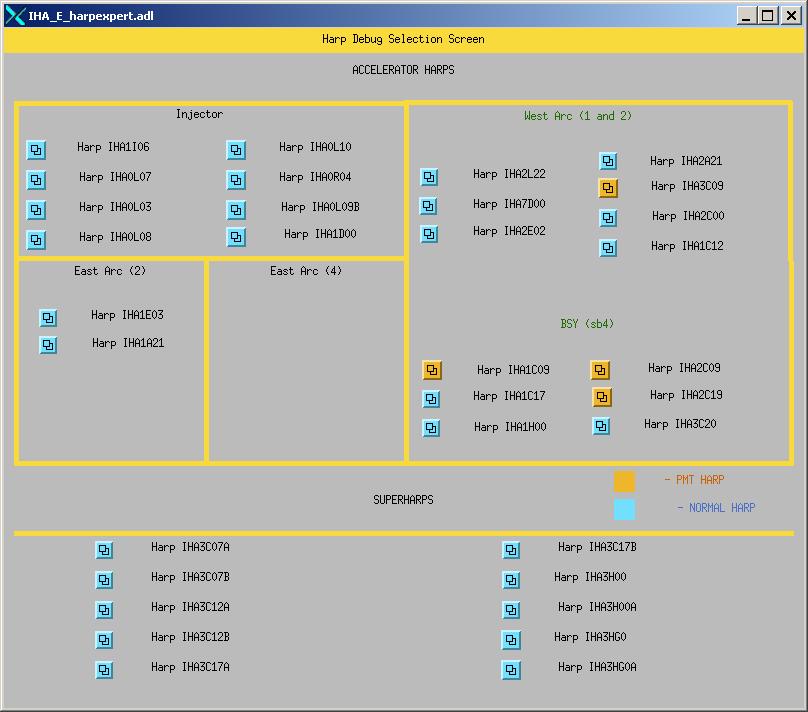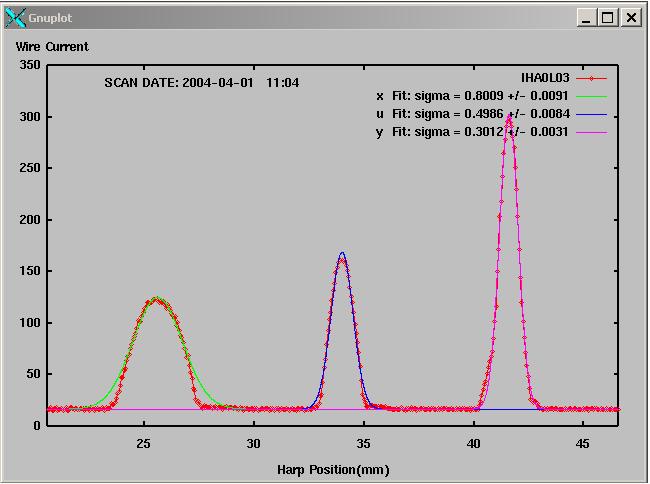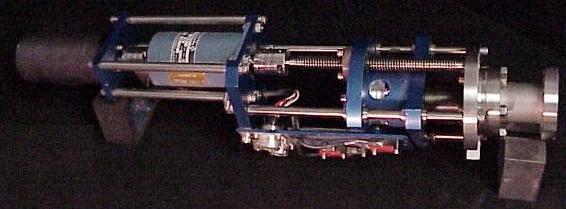Harps or Wire Scanner
There are four different types
of Harps used in the Jefferson Lab Accelerator.
They are:
1.) Accelerator Harp
2.) PMT Harp
3.) Hall C Super Harp
4.) Hall A French Harp or Wire Scanner
The MEDM screen at the right categorizes them based on their location and their type.
All of the Harps perform the same function, to provide a current profile of the beam. This is done by recording the charge and position of a very thin wire as it passes through the beam.
Using the picture below to the right...
Picture the beam as being a long tube filled with electrons. If a slice is taken across that tube we get a circle, the blue circle. Since the electrons within that slice are randomly moving within the circle, much like gas molecules bounce around the inside of a balloon, we need to incorporate probability into finding the approximate positions of the electrons within the circular slice. This curve is called a gaussian.
The image to the right is a representation of a wire being moved through the electron beam.
As the wire intercepts electrons within the beam the recorded charge will grow. When it reaches the widest portion of the beam then the curve begins to shrink back towoard zero.
If you plot the charge accumulated on the wire against position on the wire you get the a graph similar to the one at the right. This is an actual harp scan where the harp frame has 3 wires and thus 3 peaks. Further discussion of the harp mechanism is below.
They are:
1.) Accelerator Harp
2.) PMT Harp
3.) Hall C Super Harp
4.) Hall A French Harp or Wire Scanner
The MEDM screen at the right categorizes them based on their location and their type.
All of the Harps perform the same function, to provide a current profile of the beam. This is done by recording the charge and position of a very thin wire as it passes through the beam.
Using the picture below to the right...
Picture the beam as being a long tube filled with electrons. If a slice is taken across that tube we get a circle, the blue circle. Since the electrons within that slice are randomly moving within the circle, much like gas molecules bounce around the inside of a balloon, we need to incorporate probability into finding the approximate positions of the electrons within the circular slice. This curve is called a gaussian.
The image to the right is a representation of a wire being moved through the electron beam.
As the wire intercepts electrons within the beam the recorded charge will grow. When it reaches the widest portion of the beam then the curve begins to shrink back towoard zero.
If you plot the charge accumulated on the wire against position on the wire you get the a graph similar to the one at the right. This is an actual harp scan where the harp frame has 3 wires and thus 3 peaks. Further discussion of the harp mechanism is below.


The basic accelerator harp consists of an assembly that rigidly hold 3 wires in a predetermined orientation to the beam, sometimes called a fork or ladder.
The fork needs to be moved through the beam at a constant rate. This is performed by using a stepper motor which connects to the fork by a small stainless steel rod.
The entire mechanism is then enclosed inside a vacuum chamber and attached to the beam line. A bellows allows the harp to insert and retract without breaking vacuum.
The harp has 2 two limit switches located at the top and bottom of its stage to indicate when the harp has been fully inserted and when it has fully retracted to its rest position, out of the beam path.
As the wire passes through the beam it collects a very small charge on its wires. This current leaves the vacuum assembly via a BNC connector and travels to a Pre-Amplifier through a twisted pair of wires. The Preamp amplifies the x volt signal by Y which is required at the input to an Analog to Digital Converter (ADC, Card number).
For the position component of the graph a stepper motor controller card generates a number of pulses equivalent to the
the number of steps the controller has used to drive the motor in.
Then by plotting the number of steps against the charge collected by the ADC a gaussian curve can be fitted to the graph and the beam's charge profile can be determined.




